The Magnitude of a Practice: Collection and Recycling of Patinated ‘Old’ Flint Items During the Levantine Late Lower Paleolithic
Abstract
1. Introduction
2. The Archeological Sites
2.1. Revadim
2.2. Jaljulia
2.3. Qesem Cave
3. Recycling ‘Old’ Patinated Human-Made Flint Items
- Type-A recycled patinated tools consist of recycled tools detached from ‘old’ patinated flaked blanks/cores, thus, exhibiting the oldest modified patinated surfaces only on their dorsal face or striking platforms (Figure 8). Their ventral face was detached from the ‘old’ parent item, revealing the fresh color of the flint, or ventral surfaces that exhibit a less patinated condition (see, for example, Figure 8b) and, thus, counted as a new modification.
- Type-B recycled patinated tools consist of completely patinated flaked items that served as blanks to create the new tool. These recycled items preserve and exhibit most of the patinated surfaces of the ‘old’ items. In most cases, Type B recycled tools preserve almost all of the collected ‘old’ items, keeping them nearly intact, as the new modifications are few but specific aimed at creating/reshaping a working edge. They, thus, preserve most of the morphological and visual proprieties of the collected ‘old’ patinated item (Figure 9).
4. Materials and Methods
5. Results
6. Discussion and Conclusions
Supplementary Materials
Author Contributions
Funding
Data Availability Statement
Acknowledgments
Conflicts of Interest
References
- Barkai, R.; Lemorini, C.; Vaquero, M. The Origins of Recycling: A Paleolithic Perspective. Quat. Int. 2015, 361, 1–3. [Google Scholar] [CrossRef]
- Agam, A.; Barkai, R. Small Flake Acheulian: Further Insights into Lithic Recycling at Late Acheulian Revadim, Israel. Tel Aviv 2018, 45, 170–192. [Google Scholar] [CrossRef]
- Brumm, A.; Pope, M.; Leroyer, M.; Emery, K. Hominin Evolution and Stone Tool Scavenging and Reuse in the Lower Paleolithic. In Squeezing Minds from Stones: Cognitive Archaeology and the Evolution of the Human Mind; Overmann, K.A., Coolidge, F.L., Eds.; Oxford University Press: Oxford, UK, 2019; pp. 149–178. [Google Scholar]
- Delpiano, D.; Heasley, K.; Peresani, M. Assessing Neanderthal Land Use and Lithic Raw Material Management in Discoid Technology. J. Anthropol. Sci. 2018, 96, 89–110. [Google Scholar] [CrossRef]
- Mayor, A.; Sossa-Ríos, S.; Vaquero, M.; Hernández, C.M. Recycling and Implications for Neanderthal Productive Strategies in the Stratigraphic Unit Viii of the El Salt Rockshelter (Alcoi, Eastern Iberia). Lithic Technol. 2024, 1–18. [Google Scholar] [CrossRef]
- Ota, S.B.; Srivastava, N.; Pandey, S. An Early Case of Lithic Recycling in India: Evidence from the Acheulian Site at Damdongri, Madhya Pradesh. Curr. Sci. 2020, 118, 123–132. [Google Scholar] [CrossRef]
- Rosenberg-Yefet, T.; Shemer, M.; Barkai, R. Acheulian Shortcuts: Cumulative Culture and the Use of Handaxes as Cores for the Production of Predetermined Blanks. J. Archaeol. Sci. Rep. 2021, 36, 102822. [Google Scholar] [CrossRef]
- Venditti, F. Understanding Lithic Recycling at the Late Lower Palaeolithic Qesem Cave, Israel: A Functional and Chemical Investigation of Small Flakes; Archaeopress: Oxford, UK, 2019. [Google Scholar]
- Venditti, F.; Agam, A.; Barkai, R. Techno-Functional Analysis of Small Recycled Flakes from Late Acheulian Revadim (Israel) Demonstrates a Link between Morphology and Function. J. Archaeol. Sci. Rep. 2019, 28, 102039. [Google Scholar] [CrossRef]
- Venditti, F.; Cristiani, E.; Nunziante-Cesaro, S.; Agam, A.; Lemorini, C.; Barkai, R. Animal Residues Found on Tiny Lower Paleolithic Tools Reveal Their Use in Butchery. Sci. Rep. 2019, 9, 13031. [Google Scholar] [CrossRef]
- Venditti, F.; Nunziante-cesaro, S.; Parush, Y.; Gopher, A.; Barkai, R. Recycling for a Purpose in the Late Lower Paleolithic Levant: Use-Wear and Residue Analyses of Small Sharp Flint Items Indicate a Planned and Integrated Subsistence Behavior at Qesem Cave (Israel). J. Hum. Evol. 2019, 131, 109–128. [Google Scholar] [CrossRef] [PubMed]
- Venditti, F. Flint Recycling in the Lower Paleolithic Levant: A Microscopic Investigation of Small Recycled Flakes at Qesem Cave (Israel). Mitteilungen Der Ges. Für Urgesch. 2020, 29, 15–52. [Google Scholar] [CrossRef]
- Amick, D.S. Investigating the Behavioral Causes and Archaeological Effects of Lithic Artifact Recycling. In Tools Versus Cores: Alternative Approaches to Stone Tool Analysis; McPherron, S.P., Ed.; Cambridge Scholars Publishing: Newcastle, UK, 2007; pp. 223–252. [Google Scholar]
- Amick, D.S. The Recycling of Material Culture during the Paleolithic and Today. Quat. Int. 2015, 361, 4–20. [Google Scholar] [CrossRef]
- Amick, D.S. Chipped-Stone Crescents from the Terminal Pleistocene–Early Holocene of Far Western North America and the Transverse Projectile Point Hypothesis; Springer: New York, NY, USA, 2024. [Google Scholar] [CrossRef]
- Galup, S.M. Postclassic Maya Lithic Tool Maintenance, Recycling, and Consumption Patterns at Laguna de On Island; Institute for Mesoamerican Studies, University of Albany: Albany, NY, USA, 2007. [Google Scholar]
- Hocsman, S.; Alderete, M. Similar No Es Necesariamente Algo Idéntico: Reclamación de Un Diseño de Punta de Proyectil En El Tránsito a La Producción de Alimentos En Antofagasta de La Sierra (Privincia de Catamarca, Argentina). Arqueología 2022, 28, 9935. [Google Scholar] [CrossRef]
- Jennings, B. Repair, Recycle or Re-Use? Creating Mnemonic Devices Through the Modification of Object Biographies During the Late Bronze Age in Switzerland. Camb. Archaeol. J. 2014, 24, 163–176. [Google Scholar] [CrossRef]
- Parush, Y.; Yerkes, R.W.; Efrati, B.; Barkai, R.; Gopher, A. Recycling in the Neolithic, Evidence of Flint Recycling at Ein-Zippori, Israel. J. Lithic Stud. 2018, 5, 1–32. [Google Scholar] [CrossRef]
- Taxel, I. Same Medium, Different Messages: Stamped Storage Jar Handles in Judea from the Iron Age to the Early Islamic Period as Evidencing Regional Memory and Acquaintance with the Past. Time Mind 2020, 13, 35–57. [Google Scholar] [CrossRef]
- Weitzel, C.; Mazzia, N.; Hocsman, S.; Pazzi, F. Recycled Fishtail Points in the Argentinian Pampa: Everyday Tools on Distinctive Paleoamerican Objects? PaleoAmerica 2022, 8, 130–144. [Google Scholar] [CrossRef]
- Whyte, T.R. Gifts of the Ancestors: Secondary Lithic Recycling in Appalachian Summit Prehistory. Am. Antiq. 2014, 79, 679–696. [Google Scholar] [CrossRef]
- Efrati, B. Material Sense: Perceptual Experience in Stone and Mineral Selection for Tool-Making. Archaeologies 2024, 20, 24–63. [Google Scholar] [CrossRef]
- Parush, Y.; Assaf, E.; Slon, V.; Gopher, A.; Barkai, R. Looking for Sharp Edges: Modes of Flint Recycling at Middle Pleistocene Qesem Cave, Israel. Quat. Int. 2015, 361, 61–87. [Google Scholar] [CrossRef]
- Camilli, E.L.; Ebert, J.I. Artifcat Reuse and Recycling in Continuous Surface Distributions and Implications for Interpreting Land Use Patterns. In Space, Time and Archaeological Landscapes; Rossignol, J., Wandsnider, L.A., Eds.; Plenum Press: New York, NY, USA, 1992; pp. 113–136. [Google Scholar]
- Schiffer, M.B. Behavioral Archaeology: Principles and Practice; Equinox Publishing Ltd.: London, UK; Oakville, ON, Canada, 1976. [Google Scholar]
- Vaquero, M. New Perspectives on Recycling of Lithic Resources Using Refitting and Spatial Data. Quartär 2011, 58, 113–130. [Google Scholar] [CrossRef]
- Vaquero, M.; Alonso, S.; García-Catalán, S.; García-Hernández, A.; Gómez de Soler, B.; Rettig, D.; Soto, M. Temporal Nature and Recycling of Upper Paleolithic Artifacts: The Burned Tools from the Molí Del Salt Site (Vimbodí i Poblet, Northeastern Spain). J. Archaeol. Sci. 2012, 39, 2785–2796. [Google Scholar] [CrossRef]
- Goodwin, A.J.H. Chemical Alteration (Patination) of Stone. S. Afr. Archaeol. Bull. 1960, 15, 67–76. [Google Scholar] [CrossRef]
- Romagnoli, F. A Second Life: Recycling Production Waste during the Middle Palaeolithic in Layer L at Grotta Del Cavallo (Lecce, Southeast Italy). Quat. Int. 2015, 361, 200–211. [Google Scholar] [CrossRef]
- Judd, J.W. On the Unmaking of Flints. Proc. Geol. Assoc. 1887, 10, 217–226. [Google Scholar] [CrossRef]
- Nadel, D.; Gordon, D. Patination of Flint Artefacts: Evidence from Bikta, A Submerged Prehistoric Occurrence in the Sea of Galilee, Israel. Mitekufat Haeven J. Isr. Prehist. Soc. 1993, 25, 145–162. [Google Scholar]
- Purdy, B.A.; Clark, D.E. Weathering of Inorganic Materials: Dating and Other Applications. Adv. Archaeol. Method Theory 1987, 11, 211–254. [Google Scholar] [CrossRef]
- Thiry, M.; Fernandes, P.; Milnes, A.; Raynal, J.P. Driving Forces for the Weathering and Alteration of Silica in the Regolith: Implications for Studies of Prehistoric Flint Tools. Earth-Sci. Rev. 2014, 136, 141–154. [Google Scholar] [CrossRef]
- Belfer-Cohen, A.; Bar-Yosef, O. Paleolithic Recycling: The Example of Aurignacian Artifacts from Kebara and Hayonim Caves. Quat. Int. 2015, 361, 256–259. [Google Scholar] [CrossRef]
- Efrati, B.; Parush, Y.; Ackerfeld, D.; Gopher, A.; Barkai, R. Seeing Colors: Collecting and Modifying Patinated Flaked Items at Middle Pleistocene Qesem Cave, Israel. Mitekufat Haeven J. Isr. Prehist. Soc. 2019, 49, 32–62. [Google Scholar]
- Efrati, B.; Barkai, R.; Nunziante Cesaro, S.; Venditti, F. Function, Life Histories, and Biographies of Lower Paleolithic Patinated Flint Tools from Late Acheulian Revadim, Israel. Sci. Rep. 2022, 12, 2885. [Google Scholar] [CrossRef] [PubMed]
- Jagher, R. Nadaouiyeh Aïn Askar, an Example of Upper Acheulean Variability in The Levant. Quat. Int. 2016, 411, 44–58. [Google Scholar] [CrossRef]
- Peresani, M.; Boldrin, M.; Pasetti, P. Assessing the Exploitation of Double Patinated Artifacts from the Late Mousterian: Implications for Lithic Economy and Human Mobility in Northern Italy. Quat. Int. 2015, 361, 238–250. [Google Scholar] [CrossRef]
- Shimelmitz, R. The Recycling of Flint Throughout the Lower and Middle Paleolithic Sequence of Tabun Cave, Israel. Quat. Int. 2015, 361, 34–45. [Google Scholar] [CrossRef]
- Brumm, A. Lightning Teeth and Ponari Sweat: Folk Theories and Magical Uses of Prehistoric Stone Axes (and Adzes) in Island Southeast Asia and the Origin of Thunderstone Beliefs. Aust. Archaeol. 2018, 84, 37–55. [Google Scholar] [CrossRef]
- Dittert, A.E. Culture Change in the Cebolleta Mesa Region, Central Western New Mexico; University of Arizona: Tucson, AZ, USA, 1959. [Google Scholar]
- Gould, R.A. Chipping Stones in the Outback. Nat. Hist. Mag. 1968, 77, 42–49. [Google Scholar]
- Gould, R.A. Living Archaeology; Cambridge University Press: New York, NY, USA, 1980. [Google Scholar]
- Janowski, M.; Barton, H. Reading Human Activity in the Landscape: Stone and Thunderstones in the Kelabit Highlands. Indones. Malay World 2012, 40, 354–371. [Google Scholar] [CrossRef]
- Sedig, J.W. An Analysis of Non-Utilitarian Stone Point Function in the US Southwest. J. Anthropol. Archaeol. 2014, 34, 120–132. [Google Scholar] [CrossRef]
- Wandsnider, L. Long-Term Land Use, Formation Processes, and the Structure of the Archaeological Landscape: A Case Study from Southwestern Wyoming. Ph.D. Dissertation, University of New Mexico, Albuquerque, NM, USA, 1989. [Google Scholar]
- Russell, F. The Pima Indians. In Twenty-Sixth Annual Report of the Bureau of American Ethnology to the Secratary of the Smithsonian Institution 1915-1916; Holmes, W.H., Ed.; United States Government Printing Office: Washington, DC, USA, 1908; pp. 3–390. [Google Scholar]
- Sedig, J.W. Getting to the Point: An Examination of Projectile Point Use in the Northern American Southwest, A.D. 900-1300; University of Colorado: Boulder, CO, USA, 2010. [Google Scholar]
- Efrati, B. Memory Scrapers: Readymade Concepts and Techniques as Reflected in Collecting and Recycling Patinated Lower Palaeolithic Items at Qesem Cave, Israel. Camb. Archaeol. J. 2021, 31, 337–347. [Google Scholar] [CrossRef]
- Marder, O.; Malinsky-Buller, A.; Shahack-Gross, R.; Ackermann, O.; Ayalon, A.; Bar-Matthews, M.; Goldsmith, Y.; Inbar, M.; Rabinovich, R.; Hovers, E. Archaeological Horizons and Fluvial Processes at the Lower Paleolithic Open-Air Site of Revadim (Israel). J. Hum. Evol. 2011, 60, 508–522. [Google Scholar] [CrossRef] [PubMed]
- Gvirtzman, G.; Wieder, M.; Marder, O.; Khalaily, H.; Rabinovich, R.; Ron, H. Geological and Pedological Aspects of an Early-Paleolithic Site: Revadim, Central Coastal Plain, Israel. Geoarchaeology-An. Int. J. 1999, 14, 101–126. [Google Scholar] [CrossRef]
- Marder, O.; Gvirtzman, G.; Ron, H.; Khalaily, H.; Wieder, M.; Bankirer, R.; Rabinovich, R.; Porat, N.; Saragusti, I. The Lower Paleolithic Site of Revadim Quarry, Preliminary Finds. J. Isr. Prehist. Soc. 1999, 28, 21–53. [Google Scholar] [CrossRef]
- Rabinovich, R.; Ackermann, O.; Aladjem, E.; Barkai, R.; Biton, R.; Milevski, I.; Solodenko, N.; Marder, O. Elephants at the Middle Pleistocene Acheulian Open-Air Site of Revadim Quarry, Israel. Quat. Int. 2012, 276–277, 183–197. [Google Scholar] [CrossRef]
- Rosenberg-Yefet, T.; Barkai, R. Early in the Late Acheulian: Techno-Typological Analysis of the Earliest Lithic Assemblage from Lower Paleolithic Revadim, Israel. Mitekufat Haeven J. Isr. Prehist. Soc. 2019, 49, 6–31. [Google Scholar]
- Solodenko, N. On Tools and Elephants: An Analysis of the Lithic Assemblage from Area B of the Late Acheulian Site Revadim Quarry. Ph.D. Dissertation, Tel Aviv University, Tel Aviv, Israel, 2010. [Google Scholar]
- Solodenko, N.; Zupancich, A.; Cesaro, S.N.; Marder, O.; Lemorini, C.; Barkai, R. Fat Residue and Use-Wear Found on Acheulian Biface and Scraper Associated with Butchered Elephant Remains at the Site of Revadim, Israel. PLoS ONE 2015, 10, e0118572. [Google Scholar] [CrossRef]
- Zupancich, A.; Solodenko, N.; Rosenberg-Yefet, T.; Barkai, R. On the Function of Late Acheulean Stone Tools: New Data from Three Specific Archaeological Contexts at the Lower Palaeolithic Site of Revadim, Israel. Lithic Technol. 2018, 43, 255–268. [Google Scholar] [CrossRef]
- Agam, A.; Marder, O.; Barkai, R. Small Flake Production and Lithic Recycling at Late Acheulian Revadim, Israel. Quat. Int. 2015, 361, 46–60. [Google Scholar] [CrossRef]
- Malinsky-Buller, A.; Grosman, L.; Marder, O. A Case of Techno-Typological Lithic Variability & Continuity in the Late Lower Palaeolithic. Before Farming Archaeol. Anthropol. Hunt.-Gatherers 2011, 2011, 1–32. [Google Scholar] [CrossRef]
- Cohen, A. The Handaxes from Revadim Late Acheulian Quarry: Similarities and Differences in Time and Space. Ph.D. Dissertation, Tel Aviv University, Tel Aviv, Israel, 2018. [Google Scholar]
- Malinsky-Buller, A. The Muddle in the Middle Pleistocene: The Lower-Middle Paleolithic Transition from the Levantine Perspective. J. World Prehistory 2016, 29, 1–78. [Google Scholar] [CrossRef]
- Marder, O.; Milevski, I.; Matskevich, Z. The Handaxes of Revadim Quarry: Typo-Technological Considerations and Aspects of Intra-Site Variability. In Axe Age: Acheulian Toolmaking from Quarry to Discard; Goren-Inbar, N., Sharon, G., Eds.; Equinox: London, UK, 2006; pp. 223–242. [Google Scholar]
- Venditti, F.; Barkai, R.; Cesaro, S.N.; Agam, A. The Role of Side-Scrapers and Cortical Flakes in Late Acheulian Toolkits: Results of a Techno-Functional Analysis from Revadim (Israel). Lithic Technol. 2022, 47, 243–265. [Google Scholar] [CrossRef]
- Marinelli, F.; Lemorini, C.; Barkai, R. Lower Palaeolithic Small Flakes and Megafauna: The Contribution of Experimental Approach and Use-Wear Analysis to Reveal the Link. In Human-Elephant Interactions: From Past to Present; Konidaris, G.E., Barkai, R., Tourloukis, V., Harvati, K., Eds.; Tübingen University Press: Tübingen, Germany, 2021; pp. 169–192. [Google Scholar]
- Shemer, M.; Greenbaum, N.; Taha, N.; Brailovsky-Rokser, L.; Ebert, Y.; Shaar, R.; Falguères, C.; Voinchet, P.; Porat, N.; Faershtein, G.; et al. Late Acheulian Jaljulia-Eraly Human Occupations in the Paleo-Landscape of the Central Coastal Plain of Israel. PLoS ONE 2022, 17, e0267672. [Google Scholar] [CrossRef]
- Muller, A.; Barkai, R.; Shemer, M.; Grosman, L. 3D Morphology of Handaxes from Late Acheulean Jaljulia: A Flexible Reduction Strategy in the Lower Paleolithic Levant. Archaeol. Anthropol. Sci. 2022, 14, 206. [Google Scholar] [CrossRef]
- Zupancich, A.; Shemer, M.; Barkai, R. Biface Use in the Lower Paleolithic Levant: First Insights from Late Acheulean Revadim and Jaljulia (Israel). J. Archaeol. Sci. Rep. 2021, 36, 102877. [Google Scholar] [CrossRef]
- Agam, A.; Rosenberg-Yefet, T.; Wilson, L.; Shemer, M.; Barkai, R. Flint Type Analysis at Late Acheulian Jaljulia (Israel), and Implications for the Origins of Prepared Core Technologies. Front. Earth Sci. 2022, 10, 858032. [Google Scholar] [CrossRef]
- Rosenberg-Yefet, T.; Shemer, M.; Barkai, R. Lower Paleolithic Winds of Change: Prepared Core Technologies and the Onset of the Levallois Method in the Levantine Late Acheulian. Front. Earth Sci. 2022, 10, 847358. [Google Scholar] [CrossRef]
- Barkai, R.; Gopher, A. Cultural and Biological Transformations in the Middle Pleistocene Levant: A View from Qesem Cave, Israel. In Dynamics of Learning in Neanderthals and Modern Humans; Akazawa, T., Nishiaki, Y., Aoki, K., Eds.; Springer: Tokyo, Japan, 2013; pp. 115–137. [Google Scholar]
- Barkai, R.; Rosell, J.; Blasco, R.; Gopher, A. Fire for a Reason: Barbecue at Middle Pleistocene Qesem Cave, Israel. Curr. Anthropol. 2017, 58, S314–S328. [Google Scholar] [CrossRef]
- Barkai, R.; Blasco, R.; Rosell, J.; Gopher, A. A Land of Flint and Fallow Deer: Human Persistence at Middle Pleistocene Qesem Cave. In Crossing the Human Threshold: Dynamic Transformation and Persistent Places During the Middle Pleistocene; Pope, M., McNab, J., Gamble, C., Eds.; Routledge: London, UK, 2018; pp. 60–82. [Google Scholar]
- Gopher, A.; Barkai, R.; Shimelmitz, R.; Khalaily, M.; Lemorini, C.; Hershkovitz, I.; Stiner, M. Qesem Cave: An Amudian Site in Central Israel. Mitekufat Haeven J. Isr. Prehist. Soc. 2005, 35, 69–92. [Google Scholar]
- Shahack-Gross, R.; Berna, F.; Karkanas, P.; Lemorini, C.; Gopher, A.; Barkai, R. Evidence for the Repeated Use of a Central Hearth at Middle Pleistocene (300ky Ago) Qesem Cave, Israel. J. Archaeol. Sci. 2014, 44, 12–21. [Google Scholar] [CrossRef]
- Barkai, R.; Gopher, A.; Lauritzen, S.E.; Frumkin, A. Uranium Series Dates from Qesem Cave, Israel, and the End of the Lower Palaeolithic. Nature 2003, 423, 977–979. [Google Scholar] [CrossRef] [PubMed]
- Falguères, C.; Richard, M.; Tombret, O.; Shao, Q.; Bahain, J.J.; Gopher, A.; Barkai, R. New ESR/U-Series Dates in Yabrudian and Amudian Layers at Qesem Cave, Israel. Quat. Int. 2016, 398, 6–12. [Google Scholar] [CrossRef]
- Falguères, C.; Barkai, R.; Tombret, O.; Gopher, A. New ESR/U-Series Dates of the Lowest Acheulo-Yabrudian Levels of Qesem Cave. Quat. Geochronol. 2022, 69, 101266. [Google Scholar] [CrossRef]
- Gopher, A.; Ayalon, A.; Bar-Matthews, M.; Barkai, R.; Frumkin, A.; Karkanas, P.; Shahack-Gross, R. The Chronology of the Late Lower Paleolithic in the Levant Based on U-Th Ages of Speleothems from Qesem Cave, Israel. Quat. Geochronol. 2010, 5, 644–656. [Google Scholar] [CrossRef]
- Mercier, N.; Valladas, H.; Falguères, C.; Shao, Q.; Gopher, A.; Barkai, R.; Bahain, J.J.; Vialettes, L.; Joron, J.L.; Reyss, J.L. New Datings of Amudian Layers at Qesem Cave (Israel): Results of TL Applied to Burnt Flints and ESR/U-Series to Teeth. J. Archaeol. Sci. 2013, 40, 3011–3020. [Google Scholar] [CrossRef]
- Barkai, R.; Gopher, A. Innovative Human Behavior between Acheulian and Mousterian: A View from Qesem Cave, Israel. In The Lower and Middle Palaeolithic in the Middle East and Neighbouring Regions; Le Tensorer, J.-M., Jagher, R., Otte, M., Eds.; Etudes et Recherches Archéologiques de l’Université de Liège (ERAUL): Liége, Belgium, 2011; pp. 49–57. [Google Scholar]
- Barkai, R.; Lemorini, C.; Shimelmitz, R.; Lev, Z.; Stiner, M.C.; Gopher, A. A Blade for All Seasons? Making and Using Amudian Blades at Qesem Cave, Israel. Hum. Evol. 2009, 24, 57–75. [Google Scholar]
- Gopher, A.; Parush, Y.; Assaf, E.; Barkai, R. Spatial Aspects as Seen from a Density Analysis of Lithics at Middle Pleistocene Qesem Cave: Preliminary Results and Observations. Quat. Int. 2016, 398, 103–117. [Google Scholar] [CrossRef]
- Lemorini, C.; Stiner, M.C.; Gopher, A.; Shimelmitz, R.; Barkai, R. Use-Wear Analysis of an Amudian Laminar Assemblage from the Acheuleo-Yabrudian of Qesem Cave, Israel. J. Archaeol. Sci. 2006, 33, 921–934. [Google Scholar] [CrossRef]
- Parush, Y.; Gopher, A.; Barkai, R. Amudian versus Yabrudian under the Rock Shelf: A Study of Two Lithic Assemblages from Qesem Cave, Israel. Quat. Int. 2016, 398, 13–36. [Google Scholar] [CrossRef]
- Shimelmitz, R.; Barkai, R.; Gopher, A. Systematic Blade Production at Late Lower Paleolithic (400–200 Kyr) Qesem Cave, Israel. J. Hum. Evol. 2011, 61, 458–479. [Google Scholar] [CrossRef] [PubMed]
- Shimelmitz, R.; Barkai, R.; Gopher, A. Regional Variability in Late Lower Paleolithic Anudian Blade Technology: Analyzing New Data from Qesem, Tabun and Yabrud I. Quat. Int. 2016, 398, 37–60. [Google Scholar] [CrossRef]
- Agam, A.; Zupancich, A. Interpreting the Quina and Demi-Quina Scrapers from Acheulo-Yabrudian Qesem Cave, Israel: Results of Raw Materials and Functional Analyses. J. Hum. Evol. 2020, 144, 102798. [Google Scholar] [CrossRef]
- Lemorini, C.; Bourguignon, L.; Zupancich, A.; Gopher, A.; Barkai, R. A Scraper’s Life History: Morpho-Techno-Functional and Use-Wear Analysis of Quina and Demi-Quina Scrapers from Qesem Cave, Israel. Quat. Int. 2016, 398, 86–93. [Google Scholar] [CrossRef]
- Lev, Z. Techno-Typological Analysis of a Yabrudian Assemblage from Qesem Cave, Israel. Master’s Thesis, Tel Aviv University, Tel Aviv, Israel, 2010. [Google Scholar]
- Rivals, F.; Blasco, R.; Rosell, J.; Efrati, B.; Gopher, A.; Barkai, R. Seasonality, Duration of the Hominin Occupations and Hunting Grounds at Middle Pleistocene Qesem Cave (Israel). Archaeol. Anthropol. Sci. 2021, 13, 205. [Google Scholar] [CrossRef]
- Zupancich, A. Understanding the Use of Quina Scrapers at Middle Pleistocene Qesem Cave (Israel), and the Implication for the Study of the Quina Phenomenon in the Levant and Beyond. Ph.D. Dissertation, Tel Aviv University, Tel Aviv, Israel, 2019. [Google Scholar]
- Zupancich, A.; Lemorini, C.; Gopher, A.; Barkai, R. On Quina and Demi-Quina Scraper Handling: Preliminary Results from the Late Lower Paleolithic Site of Qesem Cave, Israel. Quat. Int. 2016, 398, 94–102. [Google Scholar] [CrossRef]
- Agam, A.; Wilson, L.; Gopher, A.; Barkai, R. Flint Type Analysis of Bifaces from Acheulo-Yabrudian Qesem Cave (Israel) Suggests an Old Acheulian Origin. J. Paleolit. Archaeol. 2019, 3, 719–754. [Google Scholar] [CrossRef]
- Barkai, R.; Gopher, A.; Solodenko, N.; Lemorini, C. An Amudian Oddity: A Giant Biface from Late Lower Palaeolithic Qesem Cave. Tel Aviv 2013, 40, 176–186. [Google Scholar] [CrossRef]
- Assaf, E.; Baene Preysler, J. Raw Material Selectivity in Lower Paleolithic Shaped Stone Ball Production: Experimental Research. Archaeol. Anthropol. Sci. 2022, 14, 24. [Google Scholar] [CrossRef]
- Assaf, E.; Caricola, I.; Gopher, A.; Rosell, J.; Blasco, R.; Bar, O.; Zilberman, E.; Lemorini, C.; Baena, J.; Barkai, R.; et al. Shaped Stone Balls Were Used for Bone Marrow Extraction at Lower Paleolithic Qesem Cave, Israel. PLoS ONE 2020, 15, e0230972. [Google Scholar] [CrossRef]
- Assaf, E.; Baena Preysler, J.; Bruner, E. Lower Paleolithic Shaped Stone Balls—What Is Next? Some Cultural-Cognitive Questions. Quaternary 2023, 6, 51. [Google Scholar] [CrossRef]
- Barkai, R.; Gopher, A. On Anachronism: The Curious Presence of Spheroids and Polyhedrons at Acheulo-Yabrudian Qesem Cave, Israel. Quat. Int. 2016, 398, 118–128. [Google Scholar] [CrossRef]
- Assaf, E.; Parush, Y.; Gopher, A.; Barkai, R. Intra-Site Variability in Lithic Recycling at Qesem Cave, Israel. Quat. Int. 2015, 361, 88–102. [Google Scholar] [CrossRef]
- Barkai, R.; Lemorini, C.; Gopher, A. Palaeolithic Cutlery 400,000-200,000 Years Ago: Tiny Meat-Cutting Tools from Qesem Cave, Israel. Antiquity 2010, 84, 118–128. [Google Scholar]
- Lemorini, C.; Venditti, F.; Assaf, E.; Parush, Y.; Barkai, R.; Gopher, A. The Function of Recycled Lithic Items at Late Lower Paleolithic Qesem Cave, Israel: An Overview of the Use-Wear Data. Quat. Int. 2015, 361, 103–112. [Google Scholar] [CrossRef]
- Maul, L.C.; Smith, K.T.; Barkai, R.; Barash, A.; Karkanas, P.; Shahack-Gross, R.; Gopher, A. Microfaunal Remains at Middle Pleistocene Qesem Cave, Israel: Preliminary Results on Small Vertebrates, Environment and Biostratigraphy. J. Hum. Evol. 2011, 60, 464–480. [Google Scholar] [CrossRef] [PubMed]
- Sánchez-Marco, A.; Blasco, R.; Rosell, J.; Gopher, A.; Barkai, R. Birds as Indicators of High Biodiversity Zones Around the Middle Pleistocene Qesem Cave, Israel. Quat. Int. 2016, 421, 23–31. [Google Scholar] [CrossRef]
- Agam, A. Late Lower Paleolithic Lithic Procurement and Exploitation Strategies: A View from Acheulo-Yabrudian Qesem Cave (Israel). J. Archaeol. Sci. Rep. 2020, 33, 102447. [Google Scholar] [CrossRef]
- Agam, A. Flint Procurement and Exploitation Strategies in the Late Lower Paleolithic Levant: A View from Acheulo-Yabrudian Qesem Cave (Israel); Archaeopress Publishing Ltd: Oxford, UK, 2021. [Google Scholar]
- Wilson, L.; Agam, A.; Barkai, R.; Gopher, A. Raw Material Choices in Amudian versus Yabrudian Lithic Assemblages at Qesem Cave: A Preliminary Evaluation. Quat. Int. 2016, 398, 61–69. [Google Scholar] [CrossRef]
- Verri, G.; Barkai, R.; Bordeanu, C.; Gopher, A.; Hass, M.; Kaufman, A.; Kubik, P.; Montanari, E.; Paul, M.; Ronen, A.; et al. Flint Mining in Prehistory Recorded by In Situ-Produced Cosmogenic 10Be. Proc. Natl. Acad. Sci. USA 2004, 101, 7880–7884. [Google Scholar] [CrossRef] [PubMed]
- Verri, G.; Barkai, R.; Gopher, A.; Hass, M.; Kubik, P.W.; Paul, M.; Ronen, A.; Weiner, S.; Boaretto, E. Flint Procurement Strategies in the Late Lower Palaeolithic Recorded by In Situ Produced Cosmogenic 10Be in Tabun and Qesem Caves (Israel). J. Archaeol. Sci. 2005, 32, 207–213. [Google Scholar] [CrossRef]
- Blasco, R.; Rosell, J.; Cuartero, F.; Fernández Peris, J.; Gopher, A.; Barkai, R. Using Bones to Shape Stones: MIS 9 Bone Retouchers at Both Edges of the Mediterranean Sea. PLoS ONE 2013, 8, e76780. [Google Scholar] [CrossRef] [PubMed]
- Rosell, J.; Blasco, R.; Peris, J.F.; Carbonell, E.; Barkai, R.; Gopher, A. Recycling Bones in the Middle Pleistocene: Some Reflections from Gran Dolina TD10-1 (Spain), Bolomor Cave (Spain) and Qesem Cave (Israel). Quat. Int. 2015, 361, 297–312. [Google Scholar] [CrossRef]
- Zupancich, A.; Nunziante-Cesaro, S.; Blasco, R.; Rosell, J.; Cristiani, E.; Venditti, F.; Lemorini, C.; Barkai, R.; Gopher, A. Early Evidence of Stone Tool Use in Bone Working Activities at Qesem Cave, Israel. Sci. Rep. 2016, 6, 37686. [Google Scholar] [CrossRef] [PubMed]
- Venditti, F.; Agam, A.; Tirillò, J.; Nunziante-Cesaro, S.; Barkai, R. An Integrated Study Discloses Chopping Tools Use from Late Acheulean Revadim (Israel). PLoS ONE 2021, 16, e0245595. [Google Scholar] [CrossRef] [PubMed]
- Hiscock, P. Reduction, Recycling, and Raw Material Procurement in Western Arnhem Land, Australia. In Lithic Materials and Paleolithic Societies; Adams, B., Blades, B.S., Eds.; Blackwell Publishing Ltd.: Chichester, UK, 2009; pp. 78–93. [Google Scholar]
- Hiscock, P. Recycling in the Haua Fteah Sequence of North Africa. Quat. Int. 2015, 361, 251–255. [Google Scholar] [CrossRef]
- Baena Preysler, J.; Ortiz Nieto-Márquez, I.; Torres Navas, C.; Bárez Cueto, S. Recycling in Abundance: Re-Use and Recycling Processes in the Lower and Middle Paleolithic Contexts of the Central Iberian Peninsula. Quat. Int. 2015, 361, 142–154. [Google Scholar] [CrossRef]
- Dibble, H.; Mcpherron, S. The Missing Mousterian. Curr. Anthropol. 2006, 47, 777–803. [Google Scholar] [CrossRef]
- Thiébaut, C.; Claud, E.; Mourre, V.; Chacón, M.G.; Asselin, G.; Brenet, M.; Paravel, B. The Recycling and Reuse of Cores and Bifaces during the Middle Paleolithic in Western Europe: Functional and Cultural Inrerpretations. Palethnology 2010, 3–41. [Google Scholar] [CrossRef]
- Berkes, F. Biodiversity, Religion Traditions. Encyclopedia of Biodiversity, 3rd ed.; Academy Press: Cambridge, MA, USA, 2024; Volume 3, pp. 18–29. [Google Scholar] [CrossRef]
- Assaf, E.; Barkai, R.; Gopher, A. Another Side of the Amudian Industry at Qesem Cave, Israel: The Southern Area Lithic Assemblage. Lithic Technol. 2017, 42, 161–178. [Google Scholar] [CrossRef]
- Barkai, R.; Gopher, A.; Shimelmitz, R. Middle Pleistocene Blade Production in the Levant: An Amudian Assemblage from Qesem Cave, Israel. Eurasian Prehistory 2005, 3, 39–74. [Google Scholar]
- Debénath, A.; Dibble, H.L. Handbook of Paleolithic Typology: Lower and Middle Paleolithic of Europe, Vol. 1: Lower and Middle Paleolithic of Europe; The University Museum, University of Pennsylvania: Philadelphia, PA, USA, 1994. [Google Scholar]
- Inizan, M.-L.; Reduron-Ballinger, M.; Roche, H.; Tixier, J. Technology and Terminology of Knapped Stone; Cercle de Recherches et d’Etudes Préhistoriques: Nanterre, Franch, 1999. [Google Scholar]
- Harries, J. A Stone That Feels Right in the Hand: Tactile Memory, the Abduction of Agency and Presence of the Past. J. Mater. Cult. 2017, 22, 110–130. [Google Scholar] [CrossRef]
- Wynn, T.; Overmann, K.A.; Malafouris, L. 4E Cognition in the Lower Palaeolithic. Adapt. Behav. 2021, 29, 99–106. [Google Scholar] [CrossRef]
- Malafouris, L. Knapping Intentions and the Marks of the Mental. In The Cognitive Life of Things: Recasting the Boundaries of the Mind; Malafouris, L., Renfrew, C., Eds.; McDonald Institute Monographs: Cambridge, UK, 2010; pp. 13–22. [Google Scholar]
- Malafouris, L. How Does Thinking Relate to Tool Making? Adapt. Behav. 2021, 29, 107–121. [Google Scholar] [CrossRef]
- Hahn, H.P.; Weiss, H. Introduction: Biographies, Travels and Itineraries of Things. In Mobility, Meaning & Transformations of Things: Shifting Contexts of Material Culture through Time and Space; Hahn, H.P., Weiss, H., Eds.; David Brown Book Company: Oakville, ON, Canada, 2013; pp. 1–14. [Google Scholar]
- Kopytoff, I. The Cultural Biography of Things. Commoditization as Process. In The Social Life of Things: Commodities in Cultural Perspective; Appadurai, A., Ed.; Cambridge University Press: Cambridge, UK, 1986; pp. 64–91. [Google Scholar]
- Boivin, N. From Veneration to Exploitation: Human Engagement with the Mineral World. In Soils, Stones and Symbols: Cultural Perceptions of the Mineral World; Boivin, N., Owoc, M.A., Eds.; Routledge: Abingdon, UK, 2004; pp. 1–30. [Google Scholar]
- Brumm, A. “The Falling Sky”: Symbolic and Cosmological Associations of the Mt William Greenstone Axe Quarry, Central Victoria, Australia. Camb. Archaeol. J. 2010, 20, 179–196. [Google Scholar] [CrossRef]
- Reimer, R. The Social Importance of Volcanic Peaks for the Indigenous Peoples of British Columbia. J. Northwest Anthropol. 2018, 52, 4–35. [Google Scholar]
- Taçon, P.S.C. The Power of Stone: Symbolic Aspects of Stone Use and Tool Development in Western Arnhem Land, Australia. Antiquity 1991, 65, 192–207. [Google Scholar] [CrossRef]
- Arthur, K.W. The Lives of Stone Tools: Crafting the Status, Skill, and Identity of Flintknappers; The University of Arizona Press: Tucson, AZ, USA, 2018. [Google Scholar]
- Crowell, A.L. Sea Mammals in Art, Ceremony, and Belief: Knowledge Shared by Yupik and Iñupiaq Elders. In Gifts from the Ancestors: Ancient Ivories of Bering Strait; Fitzhugh, W.W., Hollowell, J., Crowell, A.L., Eds.; Princeton University Art Museum: Princeton, NJ, USA, 2009; pp. 206–225. [Google Scholar]
- Currie, G.; Zhu, X. Aesthetic Sense and Social Cognition: A Story from the Early Stone Age. Synthese 2019, 198, 6553–6572. [Google Scholar] [CrossRef]
- Ricoeur, P. Memory, History, Forgetting; The University of Chicago Press: Chicago, IL, USA, 2004. [Google Scholar]
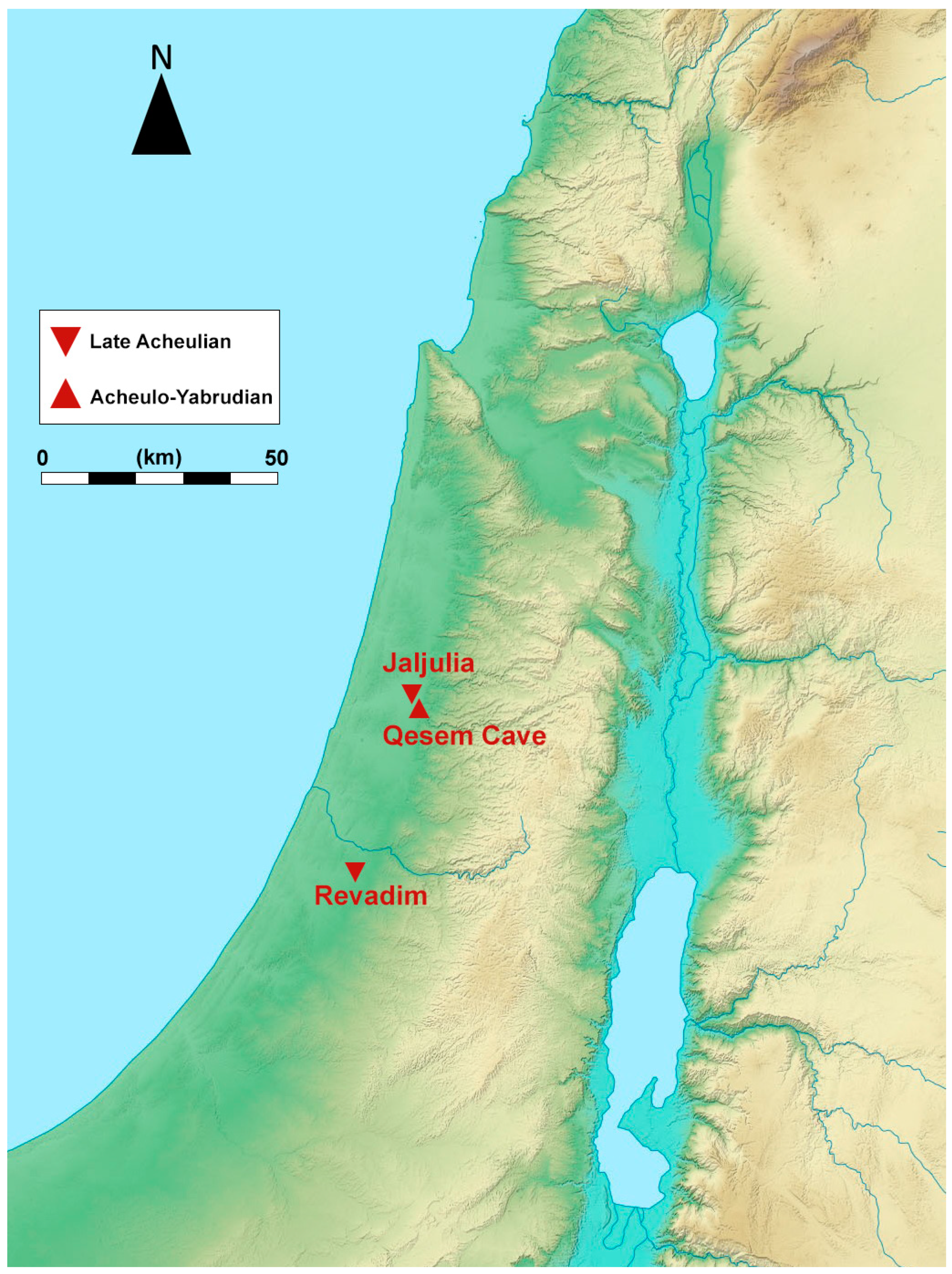
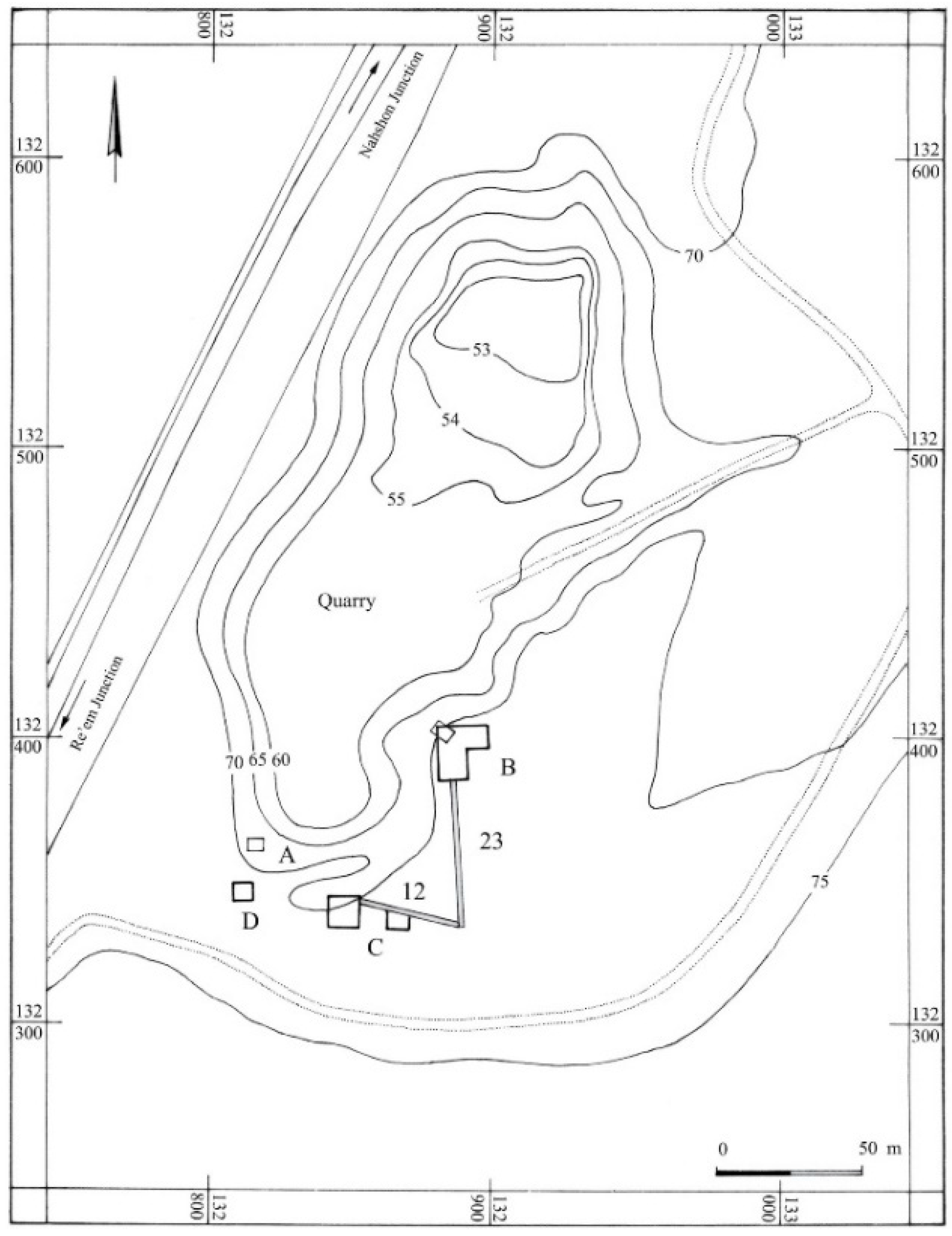
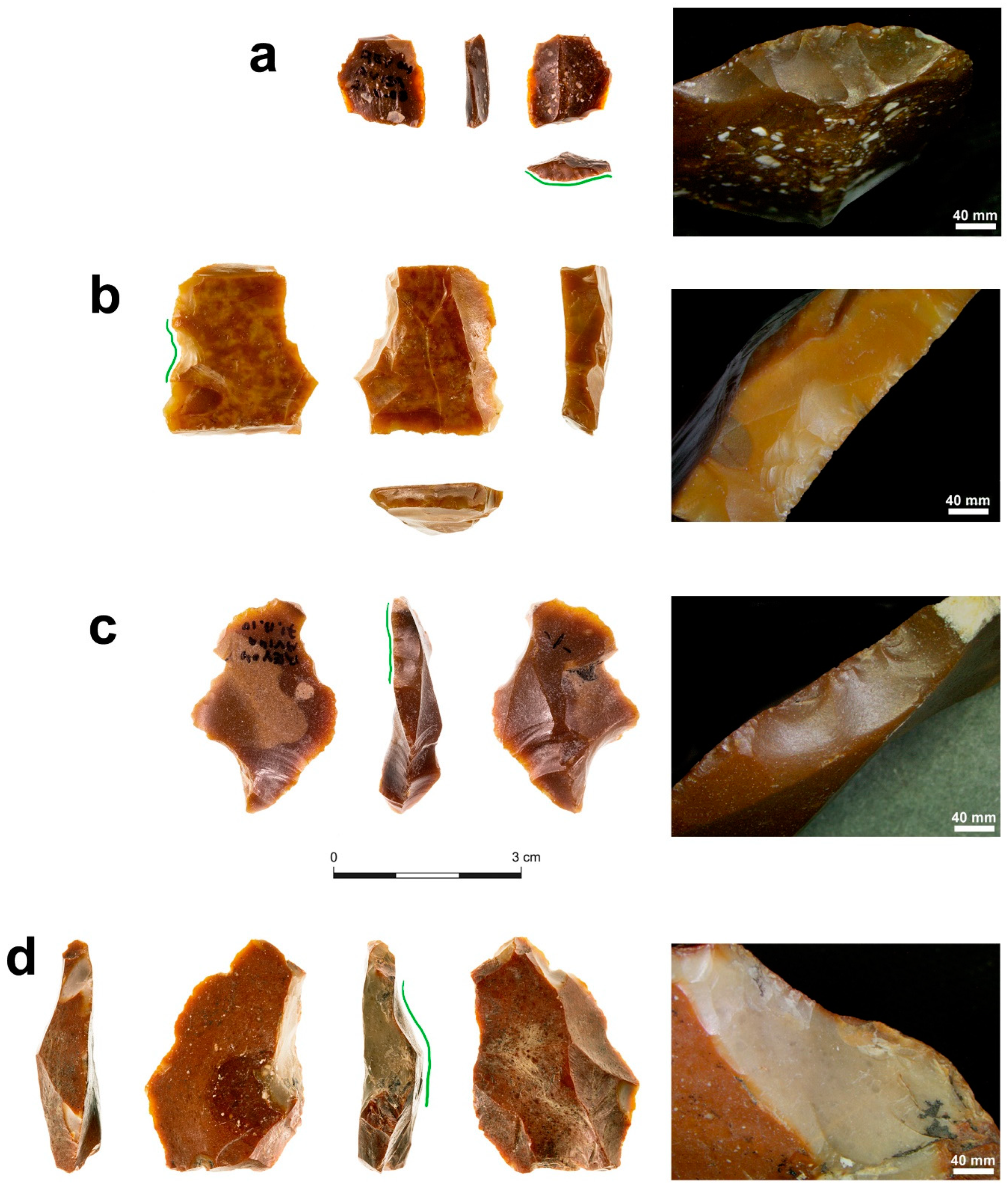
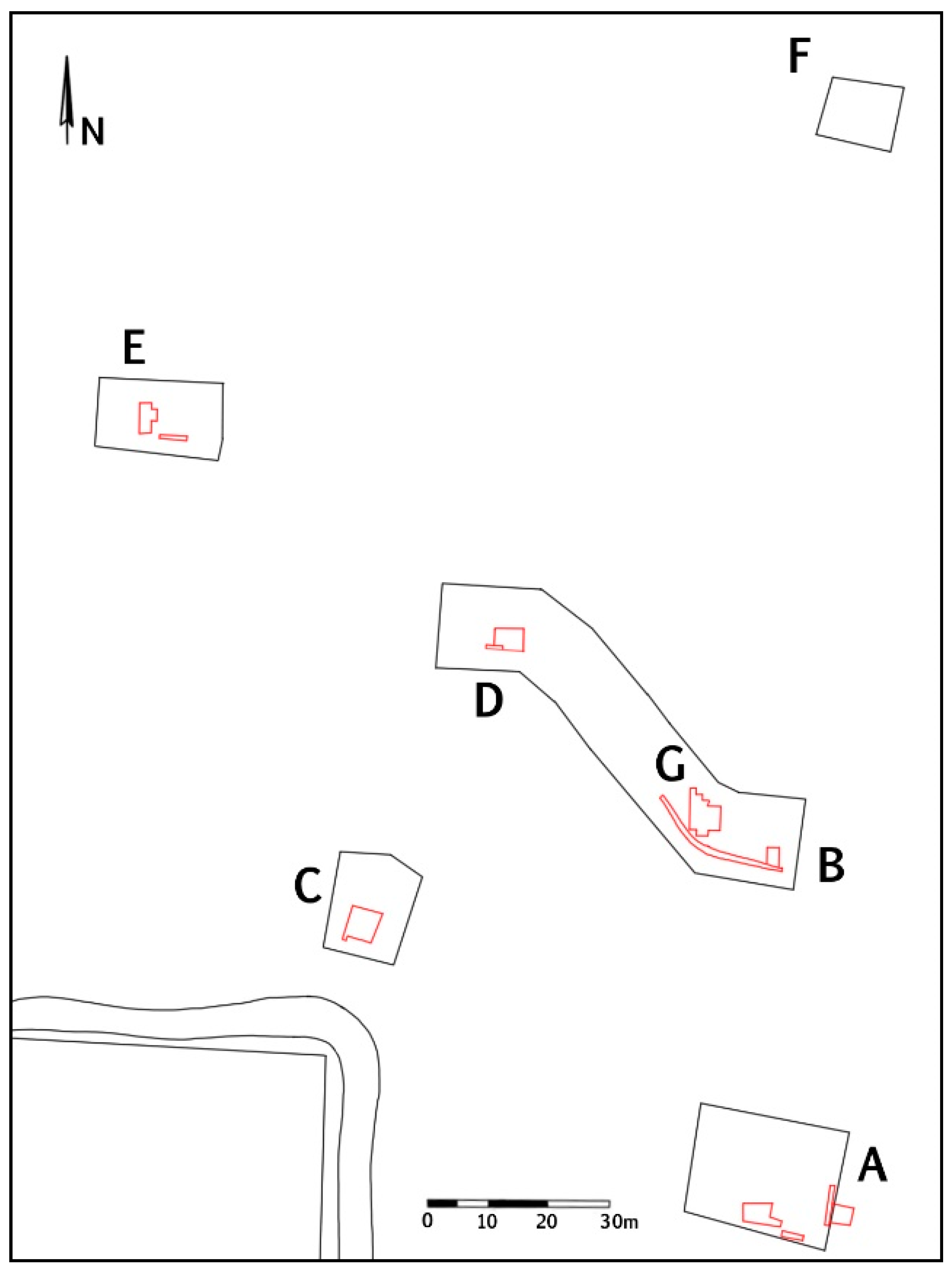
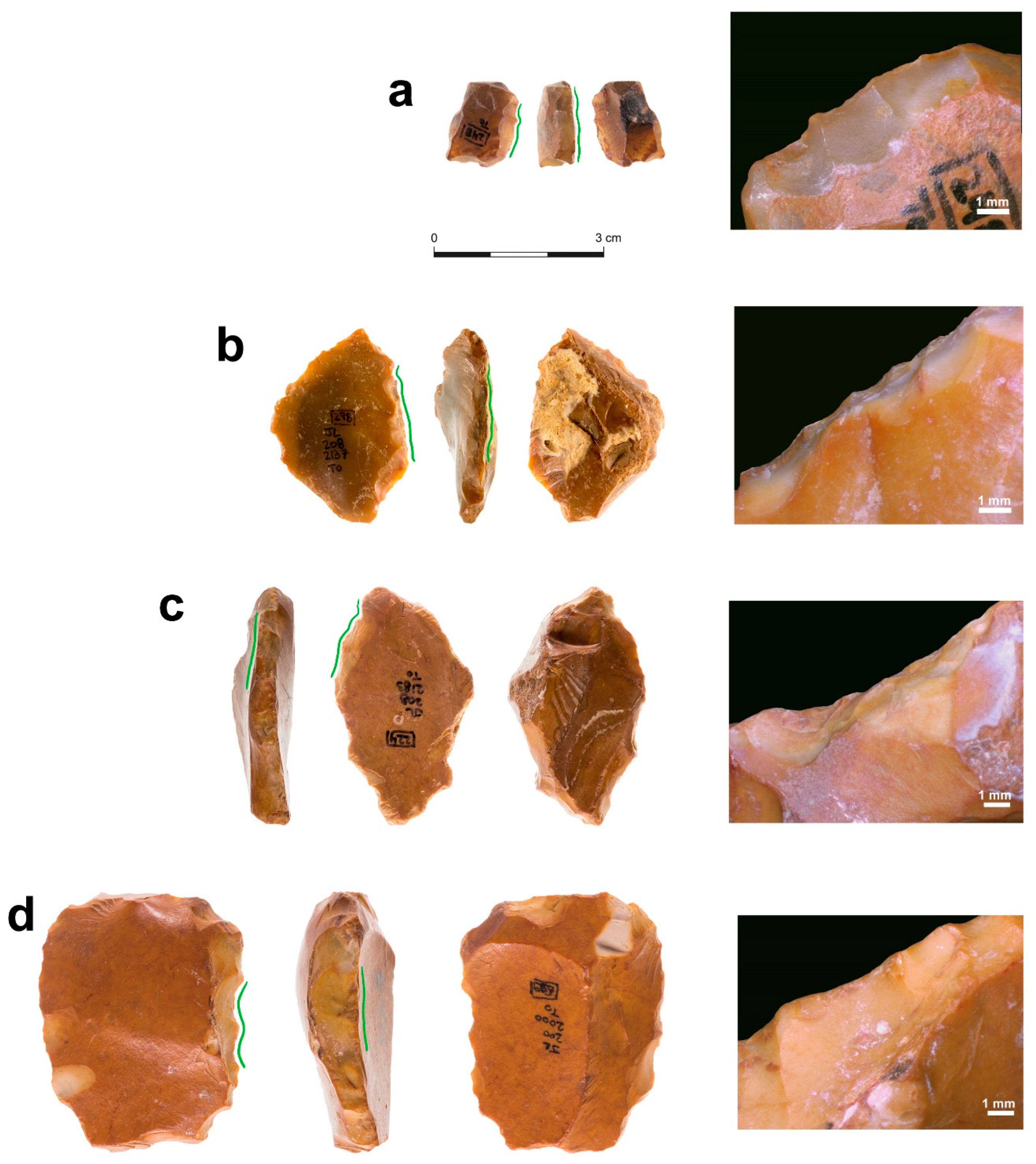
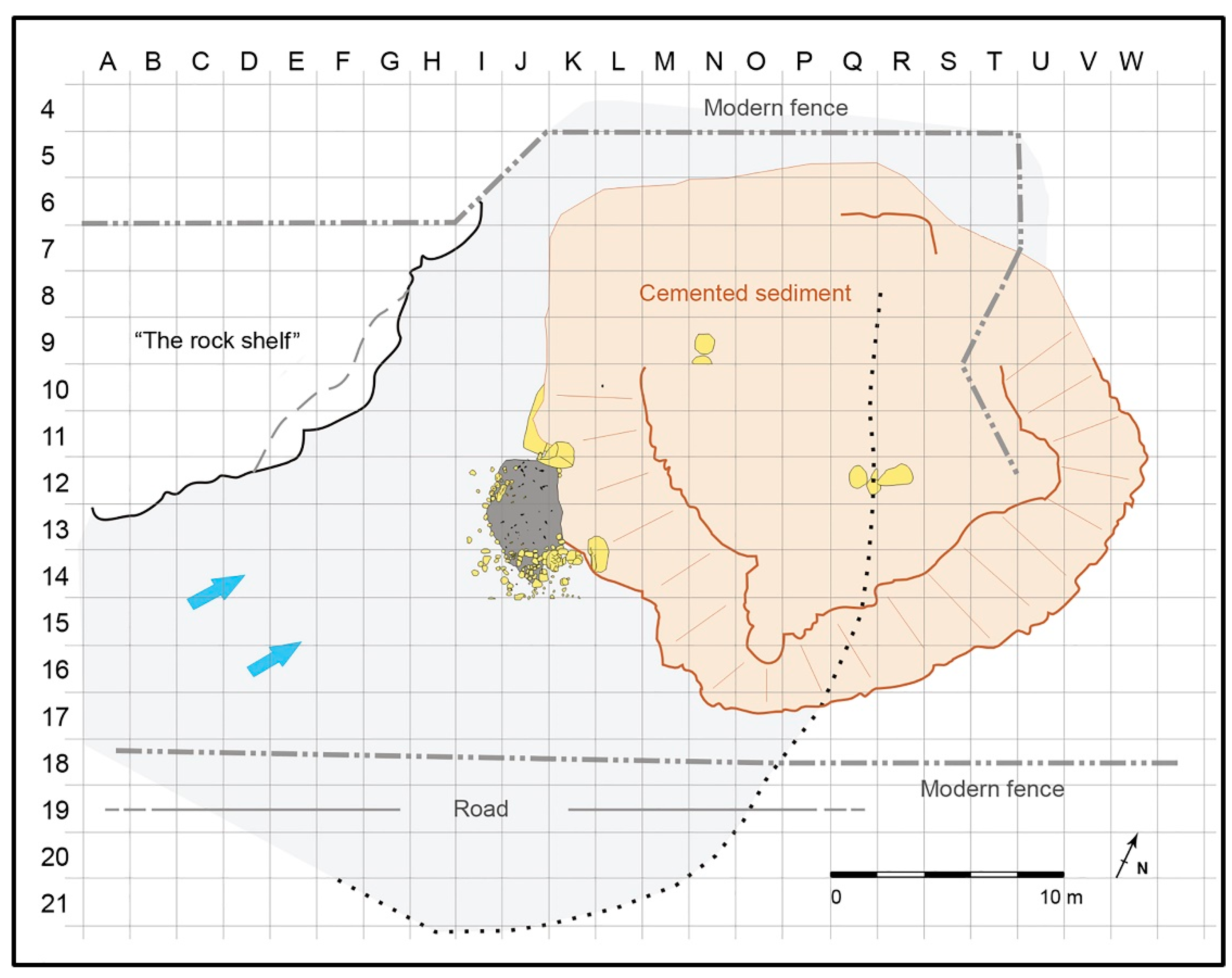
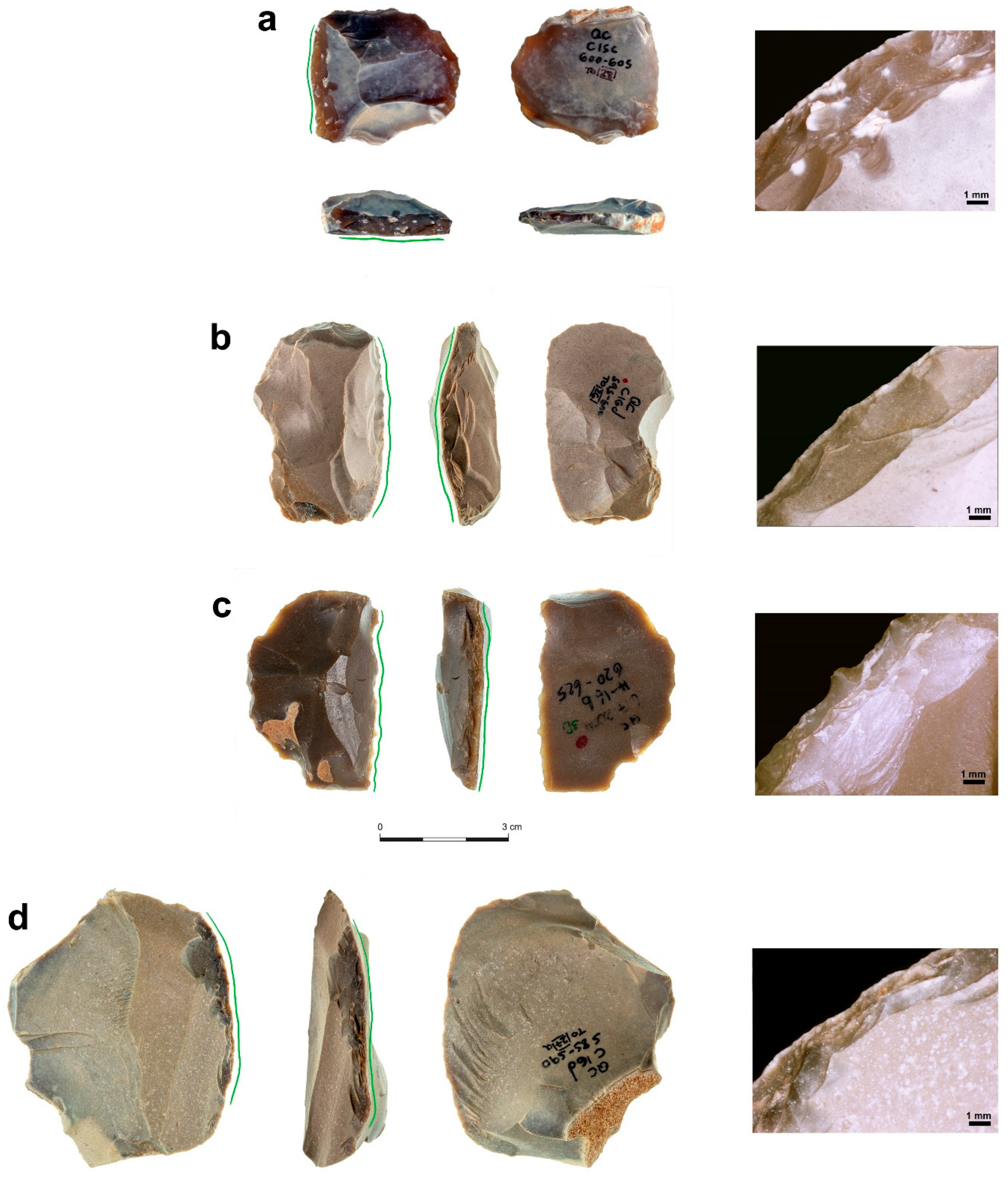
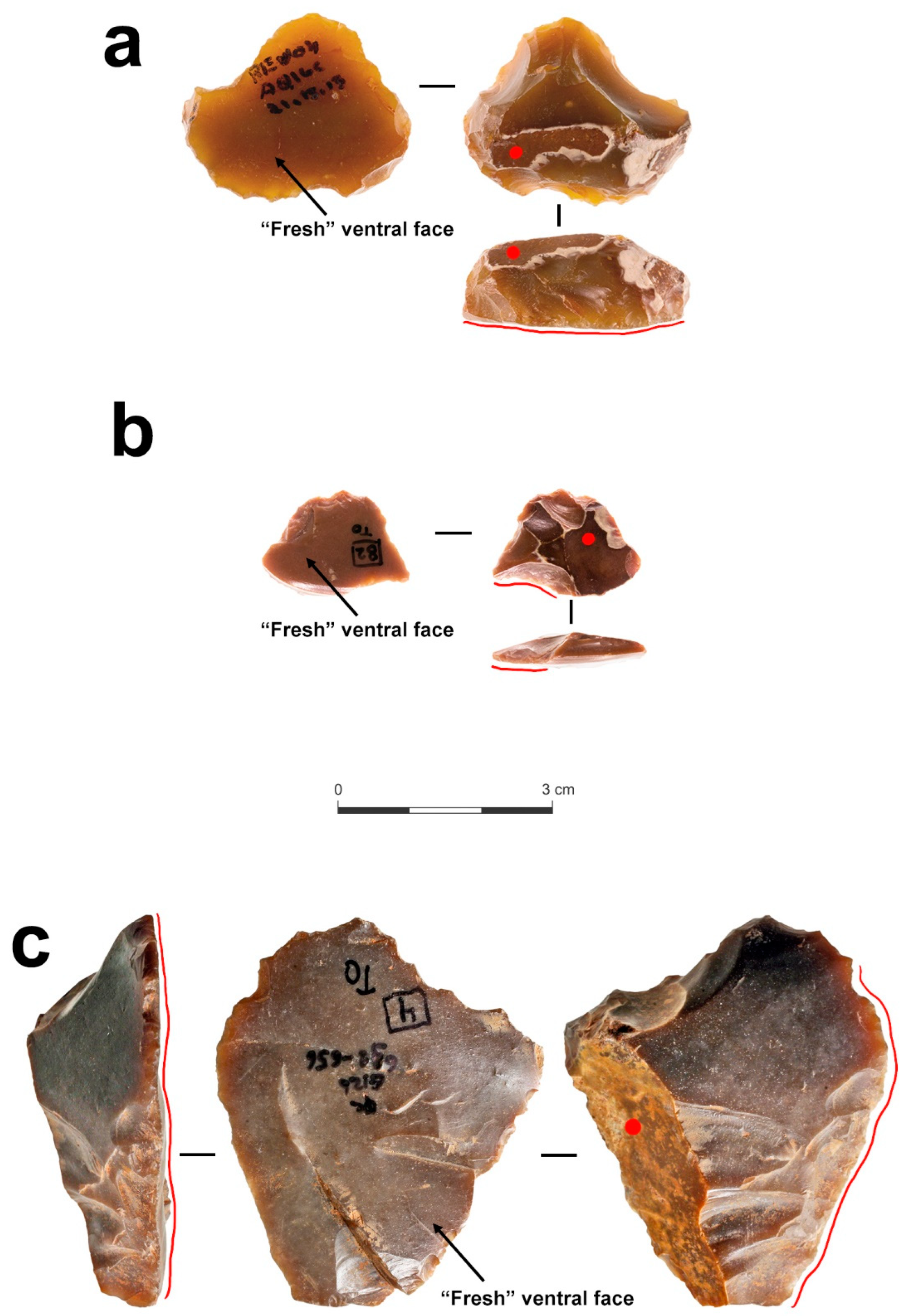
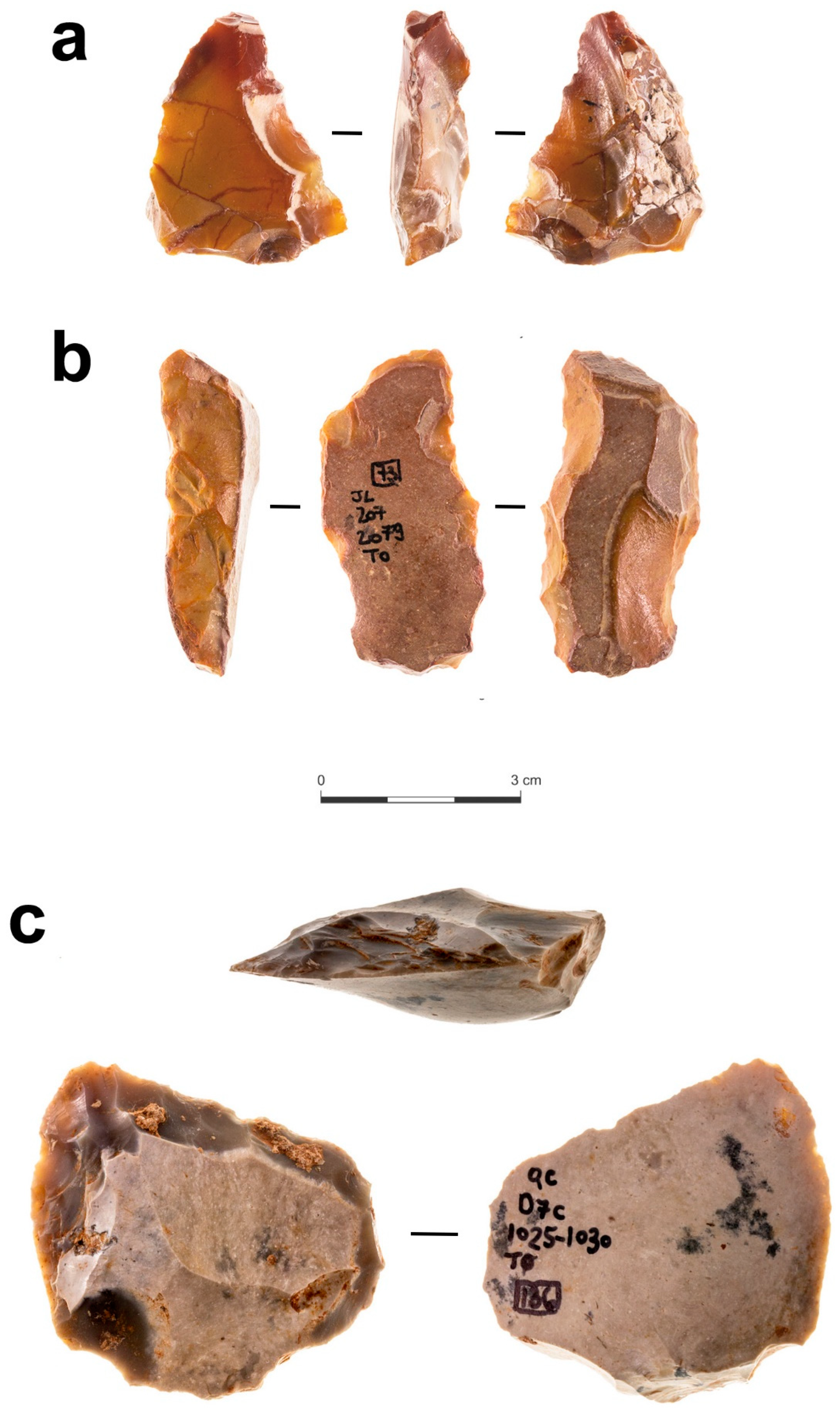
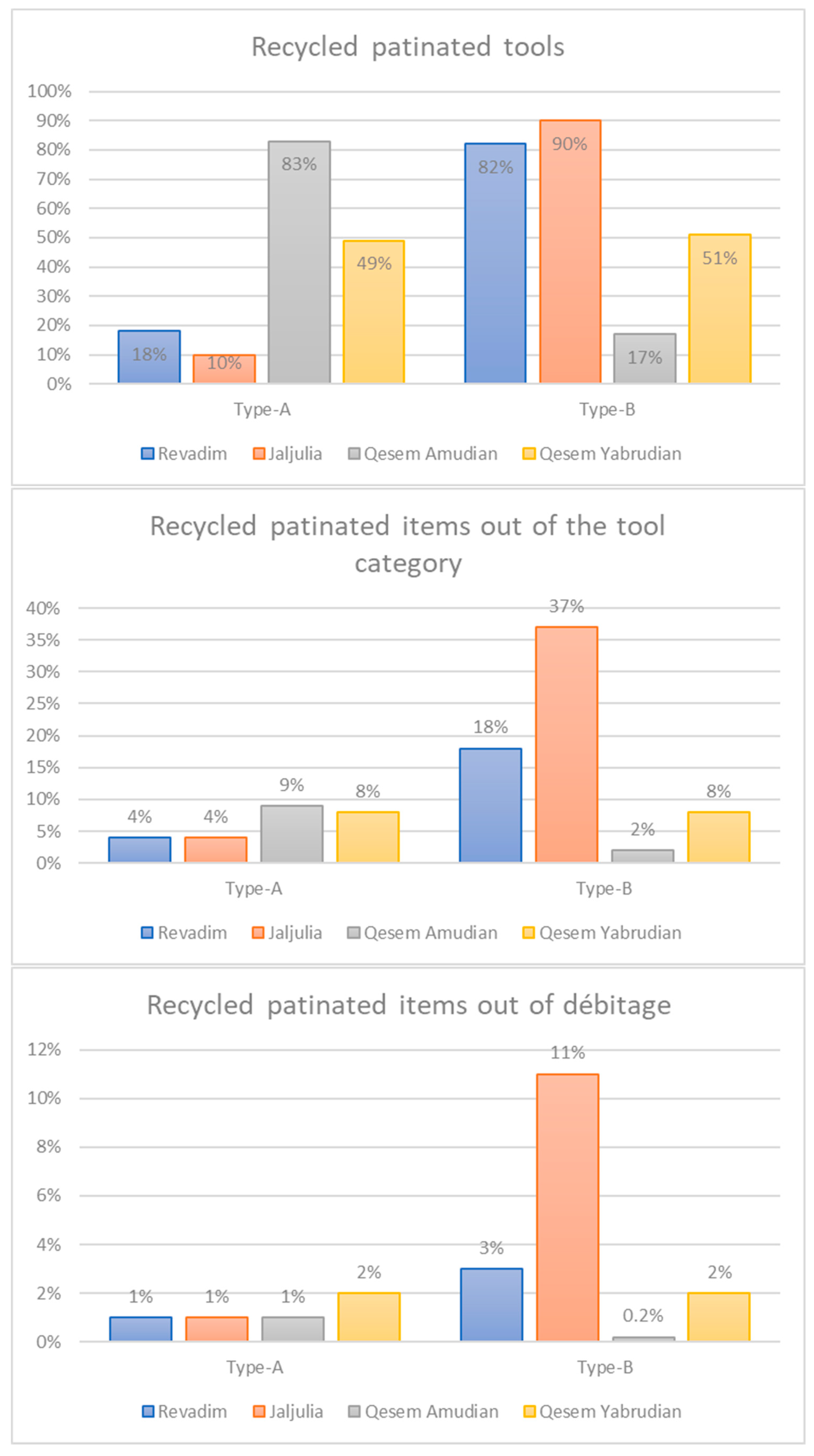
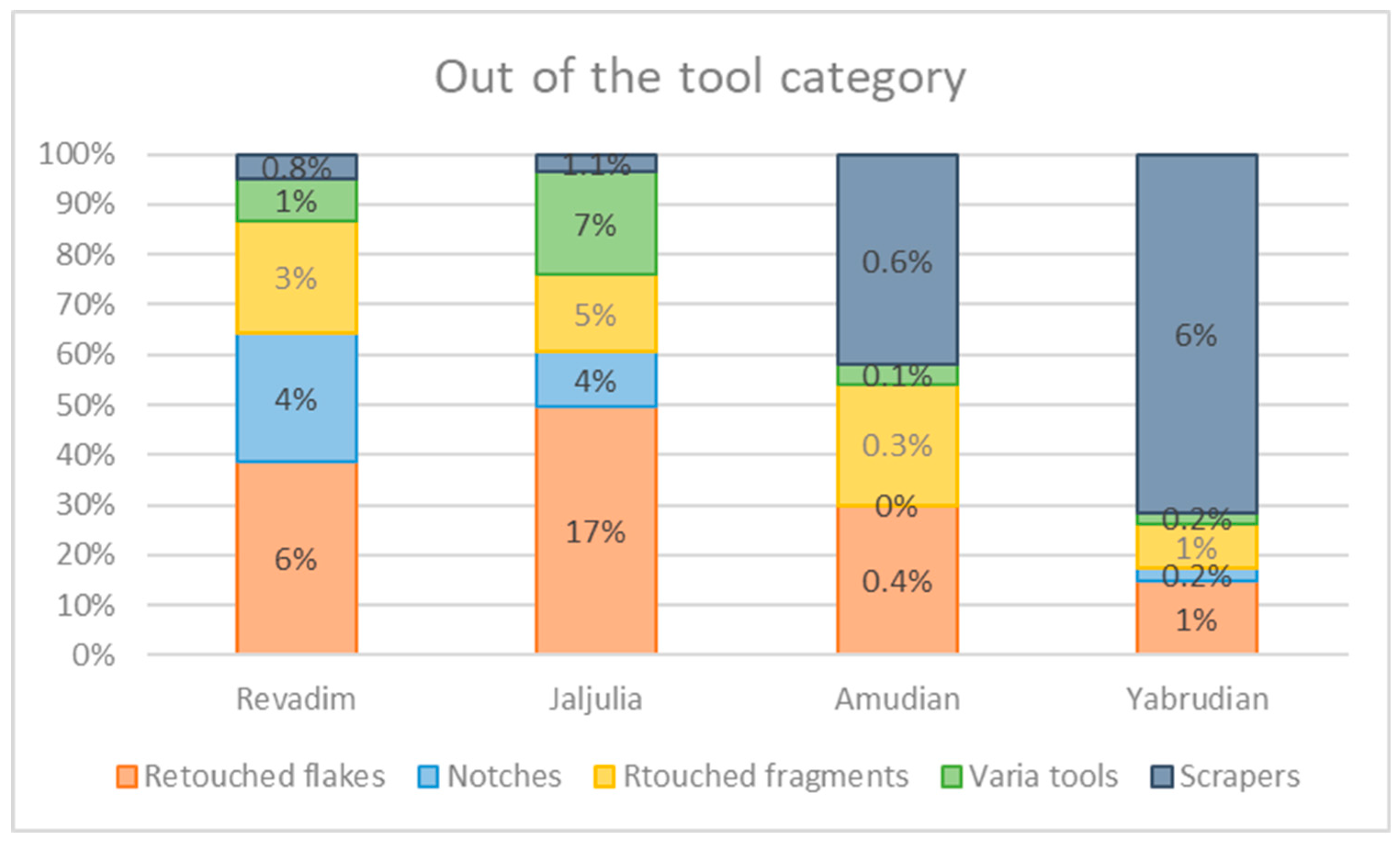
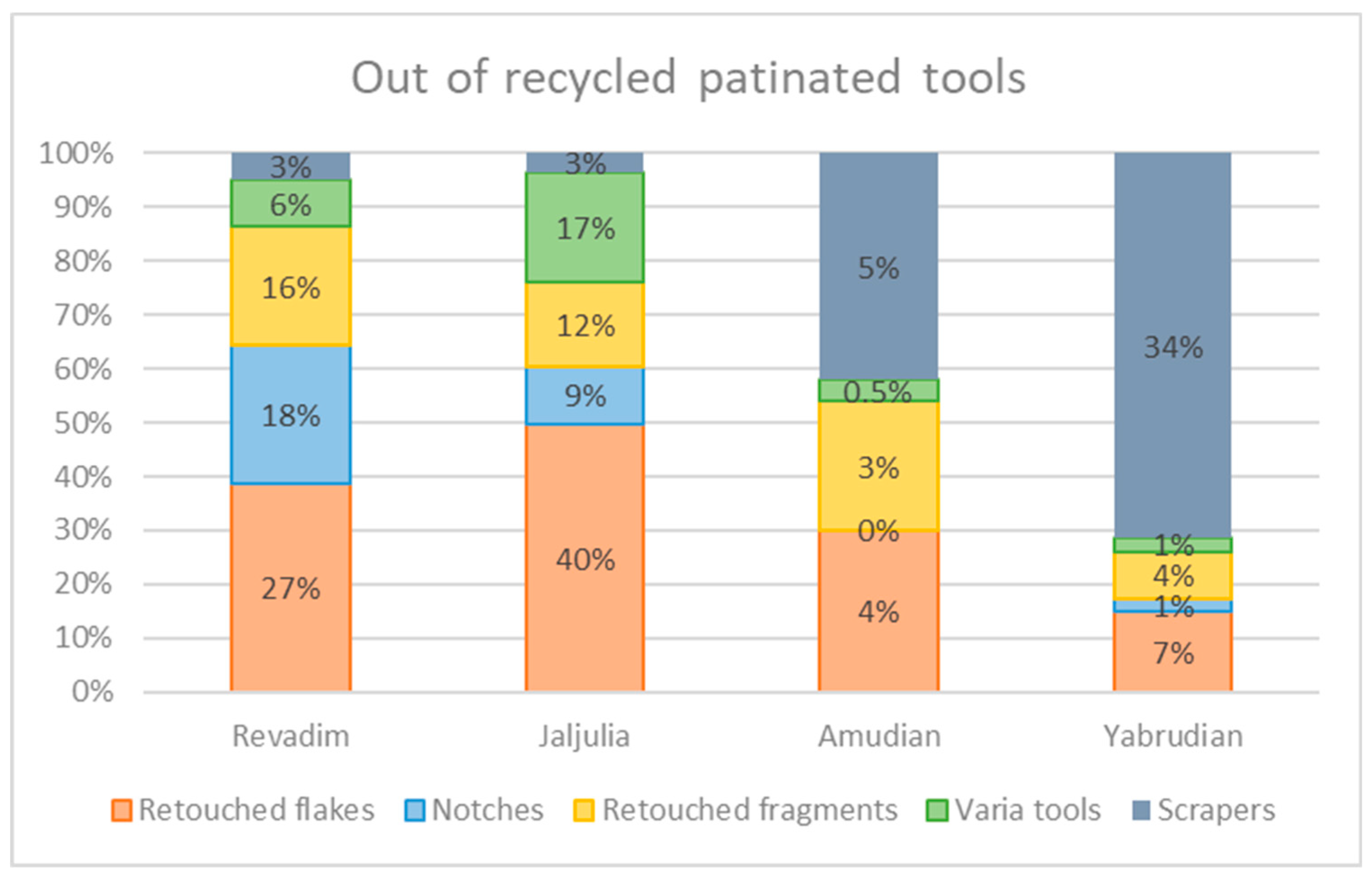
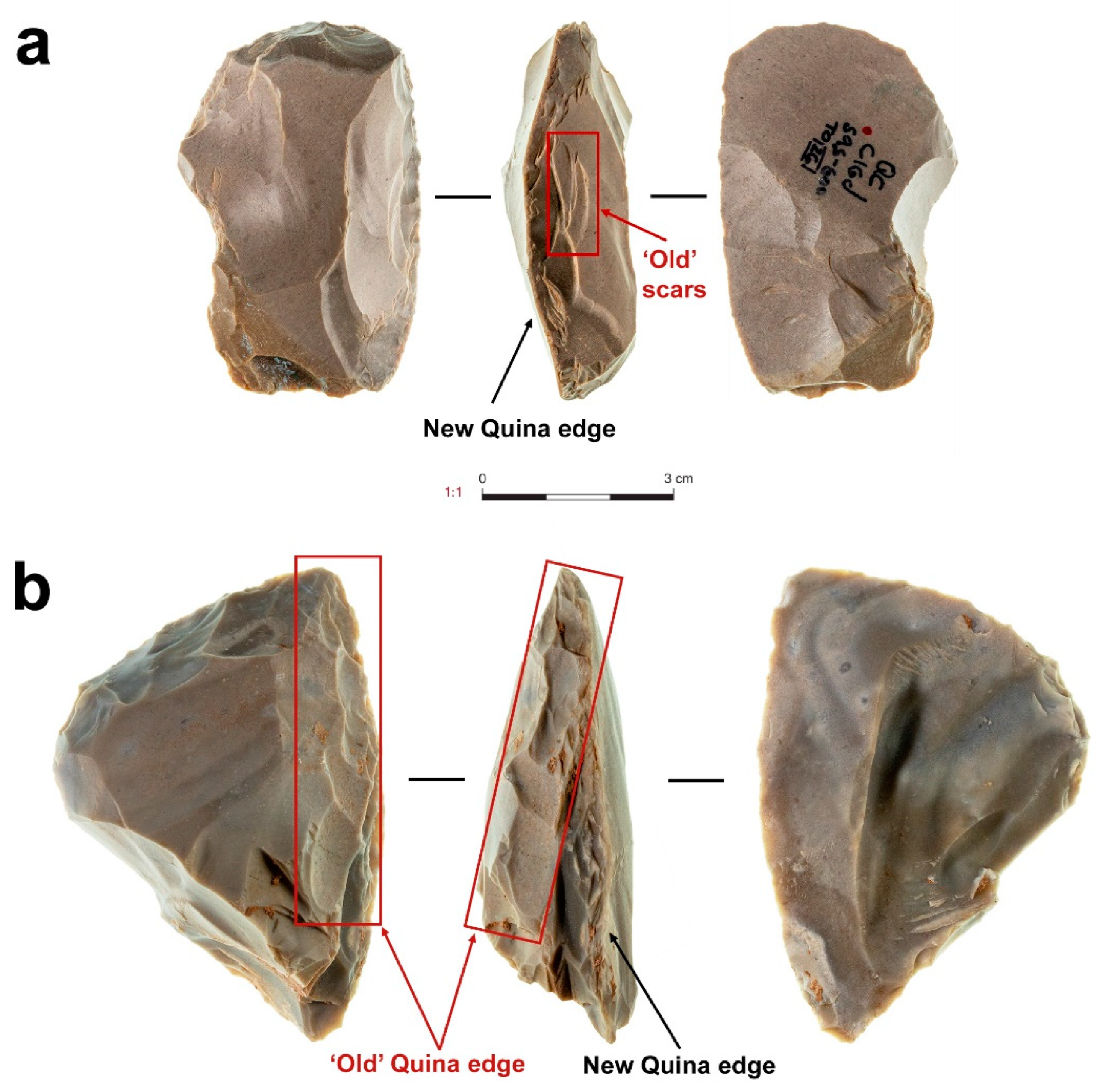
| Site | Revadim | Jaljulia | Qesem Amudian | Qesem Yabrudian |
|---|---|---|---|---|
| Débitage | 24,342 | 13,094 | 29,811 | 10,028 |
| Total number of tools | 3436 | 4036 | 3660 | 2001 |
| Recycled patinated tools | 754 | 1661 | 407 | 334 |
| Recycled patinated tools out of the tool category | 22% | 41% | 11% | 17% |
| Tools made from fresh flint | 2682 | 2375 | 3253 | 1667 |
| Fresh tools out of the tool category | 78% | 59% | 89% | 83% |
| Recycled tools knapped from old patinated items (type-A) | 139 | 163 | 337 | 165 |
| Type-A out of total débitage | 1% | 1% | 1% | 2% |
| Type-A out of the tool category | 4% | 4% | 9% | 8% |
| Type-A out of the recycled patinated tools | 18% | 10% | 83% | 49% |
| Recycled tools on patinated blanks (type-B) | 615 | 1498 | 70 | 169 |
| Type-B out of total débitage | 3% | 11% | 0.2% | 2% |
| Type-B out of the tool category | 18% | 37% | 2% | 8% |
| Type-B out of the recycled patinated tools | 82% | 90% | 17% | 51% |
| Site | Context | Débitage | Tools | Recycled Patinated Tools | Recycled Tools on Patinated Blanks (Type-B) | Type-B out of Total Débitage | Type-B out of the Tool Category | Type-B out of Patinated Tools |
|---|---|---|---|---|---|---|---|---|
| Area B, Locus 20 | 3571 | 558 | 204 | 196 | 5% | 35% | 96% | |
| Revadim | Area B, Locus 21 | 984 | 108 | 34 | 30 | 3% | 28% | 88% |
| Layer C-3 | 18,048 | 2546 | 461 | 345 | 2% | 14% | 75% | |
| Layer C-5 | 1739 | 224 | 55 | 44 | 3% | 20% | 80% | |
| Jaljulia | Area B | 6998 | 2018 | 623 | 543 | 8% | 27% | 87% |
| Area DII | 6096 | 2018 | 1038 | 955 | 16% | 47% | 92% | |
| Unit I (Amudian) | 2889 | 363 | 44 | 15 | 0.5% | 4% | 34% | |
| Qesem | K/10 (Amudian) | 1278 | 178 | 20 | 1 | 0.1% | 1% | 5% |
| Cave | G/19–20 (Amudian) | 1582 | 380 | 46 | 2 | 0.1% | 1% | 4% |
| Hearth (Amudian) | 3307 | 283 | 27 | 3 | 0.1% | 1% | 11% | |
| South of Hearth (Amudian) | 2877 | 158 | 24 | 10 | 0.3% | 6% | 42% | |
| Southern Area (Amudian) | 6145 | 597 | 93 | 12 | 0.2% | 2% | 13% | |
| Shelf (Amudian) | 7396 | 1199 | 68 | 10 | 0.1% | 1% | 15% | |
| Deep Shelf (Amudian) | 4337 | 502 | 85 | 17 | 0.4% | 3% | 20% | |
| Unit I (Yabrudian) | 455 | 109 | 23 | 8 | 2% | 7% | 35% | |
| Southwestern Area (Yabrudian) | 1394 | 294 | 32 | 19 | 1% | 6% | 59% | |
| Shelf (Yabrudian) | 4305 | 887 | 156 | 89 | 2% | 10% | 57% | |
| Deep Shelf (Yabrudian) | 3874 | 711 | 123 | 53 | 1% | 7% | 43% |
| Site | Revadim | Jaljulia | Qesem Cave Amudian | Qesem Cave Yabrudian |
|---|---|---|---|---|
| Tools | 3436 | 4036 | 3360 | 2001 |
| Recycled patinated tools | 754 | 1661 | 407 | 334 |
| Recycled tools on patinated blanks (type-B) | 615 | 1498 | 70 | 169 |
| Retouched flakes | 1385 | 1660 | 1163 | 500 |
| Recycled patinated retouched flakes | 265 | 738 | 147 | 69 |
| Recycled retouched flakes on patinated blanks (type-B retouched flakes) | 206 | 666 | 15 | 24 |
| Type-B retouched flakes out of the tool category | 6% | 17% | 0.4% | 1% |
| Type-B retouched flakes out of the recycled patinated tools | 27% | 40% | 4% | 7% |
| Type-B retouched flakes out of the retouched flakes category | 15% | 40% | 1% | 5% |
| Type-B retouched flakes out of the recycled patinated retouched flakes | 78% | 90% | 10% | 35% |
| Notches | 554 | 335 | 70 | 52 |
| Recycled patinated notches | 157 | 163 | 1 | 10 |
| Recycled notches on patinated blanks (type-B notches) | 137 | 144 | 0 | 4 |
| Type-B notches out of the tool category | 4% | 4% | 0% | 0.2% |
| Type-B notches out of the recycled patinated tools | 18% | 9% | 0% | 1% |
| Type-B notches out of the notches category | 25% | 43% | 0% | 8% |
| Type-B notches out of the recycled patinated notches | 87% | 88% | 0% | 40% |
| Retouched fragments | 750 | 848 | 767 | 378 |
| Recycled patinated retouched fragments | 155 | 242 | 79 | 31 |
| Recycled retouched fragments on patinated blanks (type-B retouched fragments) | 118 | 207 | 12 | 14 |
| Type-B retouched fragments out of the tool category | 3% | 5% | 0.3% | 1% |
| Type-B retouched fragments out of the recycled patinated tools | 16% | 12% | 3% | 4% |
| Type-B retouched fragments out of the retouched fragments Category | 16% | 24% | 2% | 4% |
| Type-B retouched fragments out of the recycled patinated retouched fragments. | 76% | 86% | 15% | 45% |
| Varia tools | 212 | 503 | 57 | 43 |
| Recycled patinated varia tools | 54 | 292 | 10 | 5 |
| Recycled varia tools on patinated blanks (type-B varia) | 46 | 276 | 2 | 4 |
| Type-B varia out of the tool category | 1% | 7% | 0.1% | 0.2% |
| Type-B varia out of the recycled patinated tools | 6% | 17% | 0.5% | 1% |
| Type-B varia out of the varia tools category | 22% | 55% | 4% | 9% |
| Type-B varia out of the recycled patinated varia tools | 85% | 95% | 20% | 80% |
| Scrapers | 59 | 108 | 170 | 461 |
| Recycled patinated scrapers | 29 | 52 | 40 | 153 |
| Recycled scrapers on patinated blanks (type-B scrapers) | 26 | 46 | 21 | 115 |
| Type-B scrapers out of the tool category | 1% | 1% | 0.6% | 6% |
| Type-B scrapers out of the recycled patinated tools | 3% | 3% | 5% | 34% |
| Type-B scrapers out of the scrapers category | 44% | 43% | 12% | 25% |
| Tpe-B scrapers out of the recycled patinated scrapers | 90% | 88% | 53% | 75% |
Disclaimer/Publisher’s Note: The statements, opinions and data contained in all publications are solely those of the individual author(s) and contributor(s) and not of MDPI and/or the editor(s). MDPI and/or the editor(s) disclaim responsibility for any injury to people or property resulting from any ideas, methods, instructions or products referred to in the content. |
© 2024 by the authors. Licensee MDPI, Basel, Switzerland. This article is an open access article distributed under the terms and conditions of the Creative Commons Attribution (CC BY) license (https://creativecommons.org/licenses/by/4.0/).
Share and Cite
Efrati, B.; Barkai, R. The Magnitude of a Practice: Collection and Recycling of Patinated ‘Old’ Flint Items During the Levantine Late Lower Paleolithic. Quaternary 2024, 7, 58. https://doi.org/10.3390/quat7040058
Efrati B, Barkai R. The Magnitude of a Practice: Collection and Recycling of Patinated ‘Old’ Flint Items During the Levantine Late Lower Paleolithic. Quaternary. 2024; 7(4):58. https://doi.org/10.3390/quat7040058
Chicago/Turabian StyleEfrati, Bar, and Ran Barkai. 2024. "The Magnitude of a Practice: Collection and Recycling of Patinated ‘Old’ Flint Items During the Levantine Late Lower Paleolithic" Quaternary 7, no. 4: 58. https://doi.org/10.3390/quat7040058
APA StyleEfrati, B., & Barkai, R. (2024). The Magnitude of a Practice: Collection and Recycling of Patinated ‘Old’ Flint Items During the Levantine Late Lower Paleolithic. Quaternary, 7(4), 58. https://doi.org/10.3390/quat7040058







